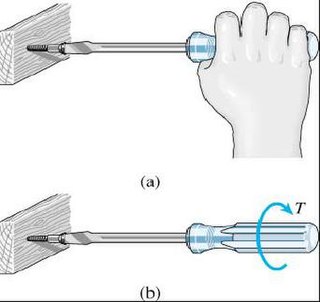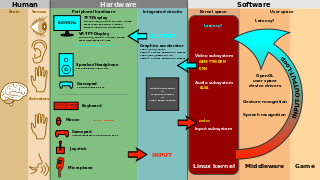Related Research Articles

Systems engineering is an interdisciplinary field of engineering and engineering management that focuses on how to design, integrate, and manage complex systems over their life cycles. At its core, systems engineering utilizes systems thinking principles to organize this body of knowledge. The individual outcome of such efforts, an engineered system, can be defined as a combination of components that work in synergy to collectively perform a useful function.
Usability testing is a technique used in user-centered interaction design to evaluate a product by testing it on users. This can be seen as an irreplaceable usability practice, since it gives direct input on how real users use the system. It is more concerned with the design intuitiveness of the product and tested with users who have no prior exposure to it. Such testing is paramount to the success of an end product as a fully functioning application that creates confusion amongst its users will not last for long. This is in contrast with usability inspection methods where experts use different methods to evaluate a user interface without involving users.
Usability engineering is a field that is concerned generally with human-computer interaction and specifically with devising human-computer interfaces that have high usability or user friendliness. It provides structured methods for achieving efficiency and elegance in interface design.

Usability can be described as the capacity of a system to provide a condition for its users to perform the tasks safely, effectively, and efficiently while enjoying the experience. In software engineering, usability is the degree to which a software can be used by specified consumers to achieve quantified objectives with effectiveness, efficiency, and satisfaction in a quantified context of use.

In systems engineering, information systems and software engineering, the systems development life cycle (SDLC), also referred to as the application development life-cycle, is a process for planning, creating, testing, and deploying an information system. The systems development life cycle concept applies to a range of hardware and software configurations, as a system can be composed of hardware only, software only, or a combination of both. There are usually six stages in this cycle: requirement analysis, design, development and testing, implementation, documentation, and evaluation.
Software prototyping is the activity of creating prototypes of software applications, i.e., incomplete versions of the software program being developed. It is an activity that can occur in software development and is comparable to prototyping as known from other fields, such as mechanical engineering or manufacturing.
Task analysis is the analysis of how a task is accomplished, including a detailed description of both manual and mental activities, task and element durations, task frequency, task allocation, task complexity, environmental conditions, necessary clothing and equipment, and any other unique factors involved in or required for one or more people to perform a given task.
Iterative design is a design methodology based on a cyclic process of prototyping, testing, analyzing, and refining a product or process. Based on the results of testing the most recent iteration of a design, changes and refinements are made. This process is intended to ultimately improve the quality and functionality of a design. In iterative design, interaction with the designed system is used as a form of research for informing and evolving a project, as successive versions, or iterations of a design are implemented.
Reliability engineering is a sub-discipline of systems engineering that emphasizes the ability of equipment to function without failure. Reliability describes the ability of a system or component to function under stated conditions for a specified period of time. Reliability is closely related to availability, which is typically described as the ability of a component or system to function at a specified moment or interval of time.

User interface design (UI) or user interface engineering is the design of user interfaces for machines and software, such as computers, home appliances, mobile devices, and other electronic devices, with the focus on maximizing usability and the user experience. The goal of user interface design is to make the user's interaction as simple and efficient as possible, in terms of accomplishing user goals.
Integrated logistic support (ILS) is a technology in the system engineering to lower a product life cycle cost and decrease demand for logistics by the maintenance system optimization to ease the product support. Although originally developed for military purposes, it is also widely used in commercial customer service organisations.
Cognitive ergonomics is a scientific discipline that studies, evaluates, and designs tasks, jobs, products, environments and systems and how they interact with humans and their cognitive abilities. It is defined by the International Ergonomics Association as "concerned with mental processes, such as perception, memory, reasoning, and motor response, as they affect interactions among humans and other elements of a system. CE is responsible for how work its done in the mind, meaning, the quality of work is dependent on the persons understanding of situations. Situations could include the goals, means, and constraints of work. The relevant topics include mental workload, decision-making, skilled performance, human-computer interaction, human reliability, work stress and training as these may relate to human-system design." Cognitive ergonomics studies cognition in work and operational settings, in order to optimize human well-being and system performance. It is a subset of the larger field of human factors and ergonomics.
The engineering design process is a common series of steps that engineers use in creating functional products and processes. The process is highly iterative - parts of the process often need to be repeated many times before another can be entered - though the part(s) that get iterated and the number of such cycles in any given project may vary.
The pluralistic walkthrough is a usability inspection method used to identify usability issues in a piece of software or website in an effort to create a maximally usable human-computer interface. The method centers on using a group of users, developers and usability professionals to step through a task scenario, discussing usability issues associated with dialog elements involved in the scenario steps. The group of experts used is asked to assume the role of typical users in the testing. The method is prized for its ability to be utilized at the earliest design stages, enabling the resolution of usability issues quickly and early in the design process. The method also allows for the detection of a greater number of usability problems to be found at one time due to the interaction of multiple types of participants. This type of usability inspection method has the additional objective of increasing developers’ sensitivity to users’ concerns about the product design.
The system safety concept calls for a risk management strategy based on identification, analysis of hazards and application of remedial controls using a systems-based approach. This is different from traditional safety strategies which rely on control of conditions and causes of an accident based either on the epidemiological analysis or as a result of investigation of individual past accidents. The concept of system safety is useful in demonstrating adequacy of technologies when difficulties are faced with probabilistic risk analysis. The underlying principle is one of synergy: a whole is more than sum of its parts. Systems-based approach to safety requires the application of scientific, technical and managerial skills to hazard identification, hazard analysis, and elimination, control, or management of hazards throughout the life-cycle of a system, program, project or an activity or a product. "Hazop" is one of several techniques available for identification of hazards.
Needs analysis is the formal process that sits alongside Requirements analysis and focuses on the human elements of the requirements.
Human error assessment and reduction technique (HEART) is a technique used in the field of human reliability assessment (HRA), for the purposes of evaluating the probability of a human error occurring throughout the completion of a specific task. From such analyses measures can then be taken to reduce the likelihood of errors occurring within a system and therefore lead to an improvement in the overall levels of safety. There exist three primary reasons for conducting an HRA; error identification, error quantification and error reduction. As there exist a number of techniques used for such purposes, they can be split into one of two classifications; first generation techniques and second generation techniques. First generation techniques work on the basis of the simple dichotomy of 'fits/doesn't fit' in the matching of the error situation in context with related error identification and quantification and second generation techniques are more theory based in their assessment and quantification of errors. HRA techniques have been utilised in a range of industries including healthcare, engineering, nuclear, transportation and business sector; each technique has varying uses within different disciplines.
Useware is a generic term introduced in 1998 that denotes all hard- and software components of a technical system which serve its interactive use. The main idea of the term Useware is the focus of technical design according to human abilities and needs. The only promising method to design future technical products and systems is to understand human abilities and limitations and to focus the technology on these abilities and limitations.
User experience evaluation (UXE) or user experience assessment (UXA) refers to a collection of methods, skills and tools utilized to uncover how a person perceives a system before, during and after interacting with it. It is non-trivial to assess user experience since user experience is subjective, context-dependent and dynamic over time. For a UXA study to be successful, the researcher has to select the right dimensions, constructs, and methods and target the research for the specific area of interest such as game, transportation, mobile, etc.

Human factors and ergonomics is the application of psychological and physiological principles to the engineering and design of products, processes, and systems. The goal of human factors is to reduce human error, increase productivity, and enhance safety and comfort with a specific focus on the interaction between the human and the thing of interest.
References
- 1 2 3 4 International Organization for Standardization. Ergonomics of human system interaction - Part 210 -: Human centred design for interactive systems (Rep N°9241-210). 2010, International Organization for Standardization
- 1 2 3 4 5 Nielsen, Usability Engineering, 1994
- 1 2 Salvemini, A. V. (1999). "Challenges for user-interface designers of telemedicine systems". Telemedicine Journal. 5 (2): 163–168. doi:10.1089/107830299312122. PMID 10908428.
- 1 2 van der Peijl, Jorien; Klein, Jan; Grass, Christian; Freudenthal, Adinda (August 2012). "Design for risk control: the role of usability engineering in the management of use-related risks". Journal of Biomedical Informatics. 45 (4): 795–812. doi: 10.1016/j.jbi.2012.03.006 . PMID 22466009.
- 1 2 3 4 Mayhew. The usability engineering lifecycle: a practitioner's handbook for user interface design. London, Academic press; 1999
- 1 2 3 Brender J. Handbook of evaluation methods for health informatics. Burlington, MA: Elsevier; 2006.
- 1 2 Schertz, JC; Saunders, H; Hecker, C; Lang, B; Arriagada, P (September 2011). "The redesigned follitropin alfa pen injector: results of the patient and nurse human factors usability testing". Expert Opinion on Drug Delivery. 8 (9): 1111–1120. doi:10.1517/17425247.2011.608350. PMID 21843107.
- 1 2 Marcilly et al., Patient Safety Oriented Usability Goals: a pilot study. MIE 2013.
- ↑ Association for the Advancement of Medical Instrumentation. Human factors engineering-design of medical devices (ANSI/AAMI HE75). Arlington, VA: AAMI; 2009.
- ↑ Smith E. Siochi A. Software usability: requirements by evaluation. In: Human factors perspectives on human-computer interaction. Santa Monica, CA: Human factors and Ergonomics Society, 1995.